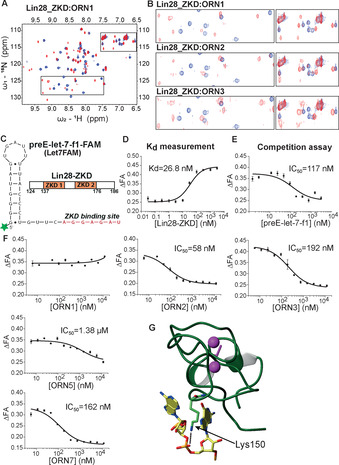Figure 2.

Fluorescence polarization competition assay with Lin28‐binding RNA mimics. A) 1H–15 N HSQC spectra of Lin28_ZKD, free (blue) and bound (red) to ORN1 at a 1:1 ratio. B) Overlay of selected 1H–15 N HSQC spectra of Lin28_ZKD, free (blue) and bound (red) to ORN1, ORN2 and ORN3 at 1:1 ratios. C) Sequence of FAM labelled preE‐let‐7f‐1 used in this study; domain structures of Lin28 (ZKD: orange; RNA residues that bind the ZKD: red). D) Fluorescence polarization assay of Lin28_ZKD binding to preE‐let‐7f‐1‐FAM. E) Competition assay using unlabeled preE‐let‐7f‐1. F) Competition fluorescence polarization assays with ORN1, ‐2, ‐3, ‐5 and ‐7. Wild‐type RNA (ORN1) is a weak competitor to preE‐let‐7f‐1. (n=3 replicates) G) The solution structure of Lin28_ZKD bound to 5′‐AGGAGAU‐3. Dotted line identifies possible interaction between Lys150 and the phosphorothioate linkage between residues A4/G5 (adapted from Ref. [13b], PDB: 2LI8).
